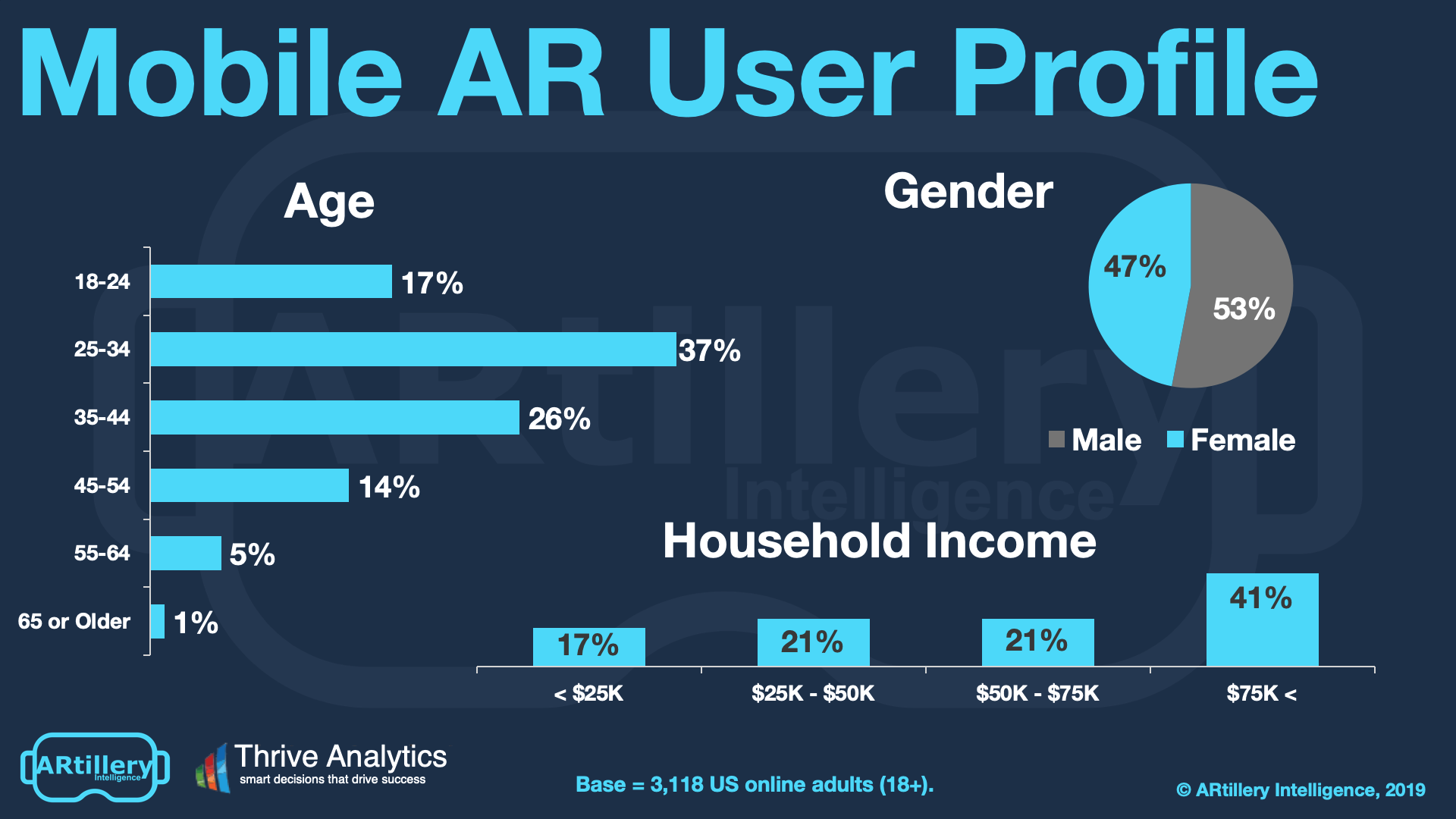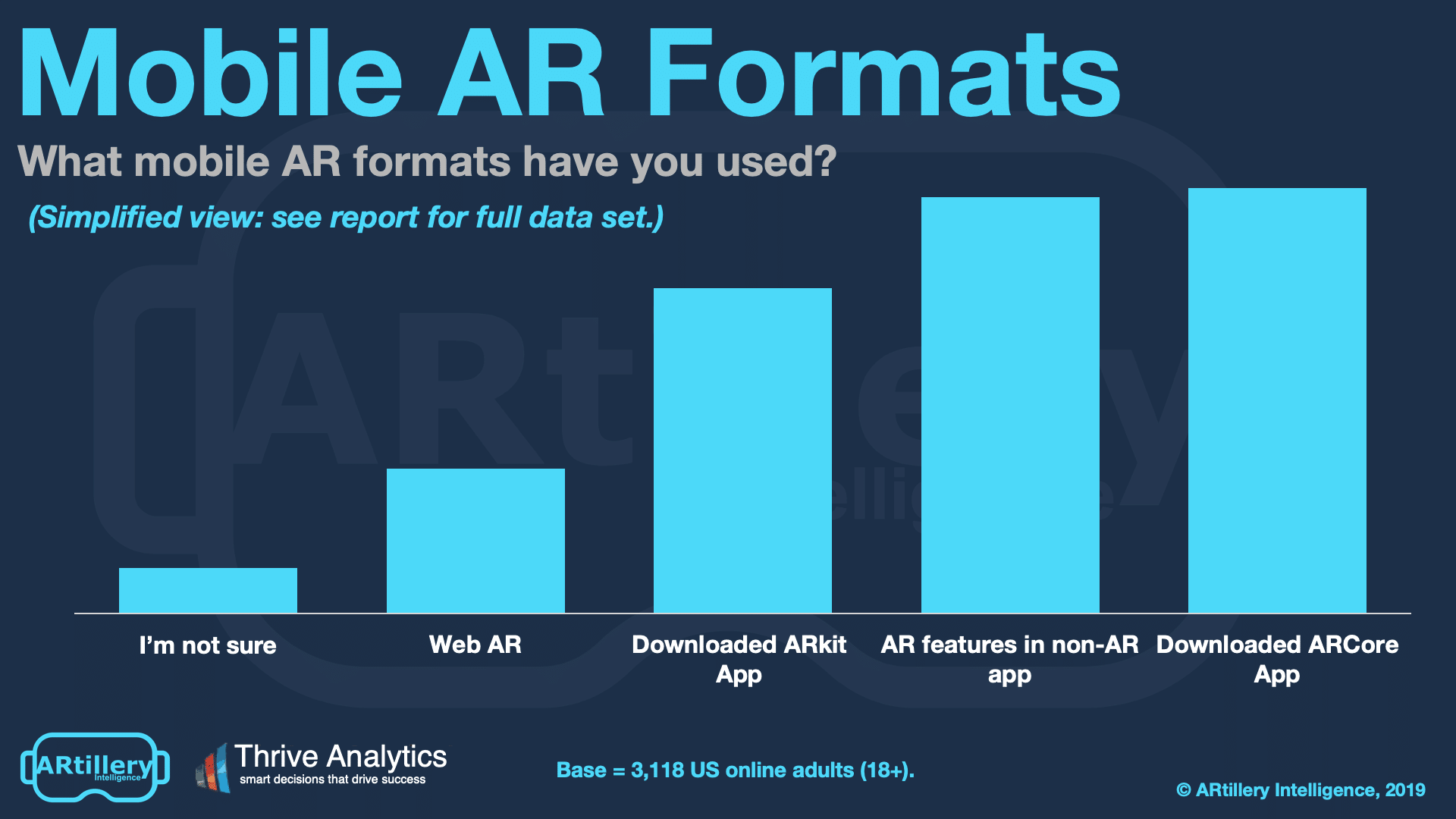
ARtillery Briefs is a video series that outlines the top trends we’re tracking, including takeaways from recent reports and market forecasts. See the most recent episode below, including narrative takeaways and embedded video.
After covering topics like social AR and AR commerce in the last few ARtillery Intelligence reports, it’s time to get a better sense of how consumers are adopting mobile AR. To put more substance and validation behind those narratives, we decided to ask real consumers how they feel.
So with our data partner Thrive Analytics, we set out for answers about how consumers are using AR. We wrote survey questions for a sample of more than 3000 U.S. adults and did a deep dive on the results and takeaways in the latest report. This represents the second year of this survey.

Positive Signs
So what were the highlights? 22 percent of survey respondents have used mobile AR. And more than half of those do so at least weekly, which is a strong metric in mobile app terms. In fact, usage frequency is an AR design target to counterbalance inherently short sessions.
Most respondents use apps, but a close second is “AR-as-a feature,” which is essentially AR features within non-AR apps. Examples include Snapchat AR Lenses and Pokemon Go (PGO). It’s a proven strategy in early days because it meets users halfway… in the apps they already use.
Web AR is also on it’s way up, with about 16 percent of AR usage. For similar reasons as AR-as-a-service, we’re bullish on web AR because of the compatibility advantages and easy onboarding of browser-based experiences. AR is too early/unproven to motivate mass downloads.
In terms of content, games lead (mostly due to PGO), followed by social AR (Mostly due to Snapchat Lenses). That’s followed by product visualization to let users “try before they buy.” Visual search also performed well in terms of a utility that helps identify real-world items.
Those last two are key because they’re inherently monetizable in facilitating commerce. Speaking of which, categories most in demand for future use include city guides and retail in-store assistance. In other words, user interest aligns with where actual business models can develop.

Selling TVs on the Radio
Another positive sign was that over 3/4 of respondents report either high or very high satisfaction with AR. Few consumer products receive satisfaction ratings that high. But the bad news is that it stood in contrast with non-users, who report low likelihood of adoption, and explicit disinterest.
This disparity between current-user satisfaction and non-user disinterest underscores an inherent challenge for AR: you have to try it first to really get it. And the experience doesn’t translate to traditional 2d marketing like photos and video, thus creating a marketing challenge.
This is similar to what Magic Leap CEO Rony Abovitz once said (paraphrasing): Selling AR is like selling televisions on the radio. The answer is to have more consumer education and distribution strategies like retail installations. In fact, Magic Leap has done just that in AT&T stores.

Solving Pain Points
Other adoption accelerants will include the viral qualities of social AR to help achieve network effect. Repeatable activities that engender stickiness will also gain consumer traction, such as social messaging or gamified experiences. Those factors can be seen in AR Lenses and PGO.
Lastly, AR that creates what we call “all-day” use cases will pull ahead. That moves beyond sexy app categories like social and gaming, to more mundane utilities that solve everyday problems. So we’re bullish on potentially high-frequency AR utilities like Visual Search, a la Google Lens.
In summary, most of the survey results are positive signals for AR, but they also indicate that we have a ways to go to achieve mass appeal. Getting there will involve a combination of these high scoring attributes like social-based network effect, gamification and solving everyday pain points.
See the full episode below and preview the report here.
For deeper XR data and intelligence, join ARtillery PRO and subscribe to the free AR Insider Weekly newsletter.
Disclosure: AR Insider has no financial stake in the companies mentioned in this post, nor received payment for its production. Disclosure and ethics policy can be seen here.
